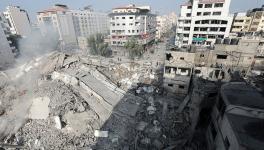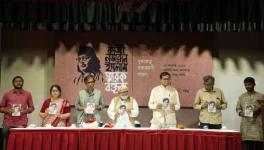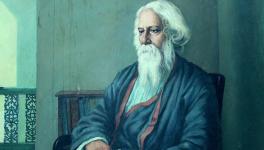The Poet in Persia: Revisiting Tagore’s Critique of Aerial Bombardment
Image Courtesy: Wikimedia Commons
Rabindranath Tagore celebrated his 71st birthday in Tehran. He visited Iran and Iraq as a state guest from April to June 1932. His travelogue was soon serialised as Parasyajatra (Journey to Persia) and Parasyabhraman (Travels through Persia) in two leading Bangla journals, Prabasi and Bichitra, respectively. In 1936, it was re-published with his travelogue of Japan — a country he had visited thrice — as Japane-Parasye (In Japan, In Persia).
This work of Tagore would appear in print again as a stand-alone monograph titled Parasya-Jatri (Traveller to Persia) in 1963, more than two decades after his demise. It would also find its way into the Rabindra Rachanabali — that veritable compendium of Tagore’s entire written corpus — first published by Visva Bharati and later in a more economical edition by the Government of West Bengal as well. It is, therefore, quite surprising that a widely circulated text would largely escape the notice of many readers — lay and scholarly — who have poured deep into Tagore’s oeuvre to discern his political opinion, except for two: the Marxist philosophers Debiprasad Chattopadhyaya and Ramkrishna Bhattacharya.
If one pays attention to just the first chapter of this travelogue, which, in a typical Tagorean vein, is replete with eclectic ruminations on religious philosophy and the contemporary political situation, one will discover a potent, cogent, and uncompromising critique of imperialist warfare and its most modern weapon at that time: aerial bombardment.
It should not surprise anybody that a humanist poet and an ardent critic of nationalism like Tagore was against the war in all its forms and guises. A lot has already been written about his deep commitment to world peace, to which he gestured not merely rhetorically but also politically.
Tagore is said to have corresponded with Bertha von Suttner, the first woman to have been awarded the Nobel Peace Prize before the outbreak of the First World War. In the inter-war years, he sustained an intimate intellectual engagement with the French litterateur Romain Rolland. He lent active support to the global campaign for peace that Rolland spearheaded with the French Communist writer Henri Barbusse among others. He even became the President of the Indian chapter of the League Against Fascism and War and sent his message of solidarity to the World Peace Congress, held in Brussels in September 1936.
Tagore’s abiding pacifism had its indelible imprint on his last public address too, titled Crisis in Civilization, delivered just months before he died in 1941. What, then, is so distinct about his critique of the war in Parasya-Jatri? In my opinion, the specific form of aerial bombardment — asymmetric, impersonal, and somewhat even automated — so disconcerted him as he contemplated and anticipated its many implications in the years to come.
During the First World War, the military airpower of the belligerents was still quite rudimentary. However, figures like Italian General Giulio Douhet had already started advocating strategic bombing to batter down civilian morale in the early 1920s. Tagore would not, of course, be able to witness all the horrors of the Second World War — the coming of age of aerial bombardment and the inauguration of nuclear warfare — but his prescient observations would ring true wherever the bombs dropped. People died well into the future: in Korea, Vietnam, Serbia, and Syria.
These observations on why aerial bombardment from a distance, when the opponents are manifestly outmatched, can loosen a conscience’s grip on humanity itself were made by Tagore during his first long-distance air travel from Calcutta in Bengal to Bushehr in Persia, with pitstops at Allahabad, Jodhpur, and Karachi, in the summer of 1932.
Tagore was well aware of how seriously his public utterances and published writings were taken by the readership. Consequently, in an essay published as part of an anthology titled Kalantar in 1937, he had not forgotten to forewarn his reader:
When I get to hear that someone is trying to unearth my considered opinion on politics, society, and religion from my writings, I know for sure that his own opinion will inevitably be amalgamated with mine. Documentary testimony, when presented with an advocate’s interpretation, cannot be deemed to be evidence per se. Because the same evidence could be cited by the opposing counsel to argue the contrary. The reason behind this is selectivity: the specific meaning of an utterance depends on the specific use for which it has been selected. (Kalantar, 341)
Lest it should come off as an attempt to make Tagore posthumously speak what he did not intend, I will quote in length here from Parasya-Jatri so that the reader may think of this passage what they will:
The higher the aircraft arose, the feebler our sensory attachments with the earth became, reduced in the end to sight alone, that too not very intimately. This planet, which I had come to know as evidently variegated and certain, gradually grew fainter — the three-dimensional reality morphed into a two-dimensional picture. Creation manifests itself in diverse guises within specific structures of integrated spacetime. When those structures tend to become increasingly uncertain, creation gives in to dissolution. As the earth before our eyes dissolved into a blur, its identity grew obscure, and its existential claims on our minds weakened. It seemed that in similar circumstances, when men set out to rain down hundreds of explosives from an aeroplane, they can become ruthlessly dangerous — their conscience can no longer temper their fury — and in the absence of any accountability, they lose all sense of dilemma and propriety.
When the reality towards which men tend to be so habitually merciful grows dimmer, the very vessel of mercy disappears altogether. The theoretical injunction of the Gita is also like an aircraft — it lifted Arjuna’s compassionate mind to such dizzying heights from where the killer and the killed friend and foe could hardly be distinguished. Men have many such theory-forged aircraft in their arsenal to occlude reality — they proliferate in their imperial, social, and religious doctrines. Those who find themselves at the receiving end of such violence are offered only this cursory consolation: ‘it [the soul] is not slain when the body is slain.’
The British have a military airbase in Baghdad. A Christian priest affiliated with that air force informed me that they had been regularly bombing a village of Sheikhs nearby. The women, children, and elderly who are dying there are being thrashed literally from the higher echelons of the British Empire; they can be killed so easily because imperialism can obscure the identity of the individual so effectively.
Christ has acknowledged these people as the children of his heavenly father too, but for this Christian priest, the father and his children have become unreal; they cannot be recognised from the aircraft of lofty imperial theory, which is why the bombs are falling on Christ’s chest across the empire today. Besides, it is so convenient to bomb these desert-dwellers from the safety of the aeroplane without any fear of retaliation that the very violence of the act appears unreal. Those who can be killed with impunity do not seem tangible enough to their killers. For this reason, the humanity of those who are not proficient in the Western science of annihilation is becoming hazier in the eyes of Western combatants.
The Christian priest sought my message for their aerial campaign over Iraq; let me publish what I sent him here: ‘From the beginning of our days, man has imagined the seat of divinity in the upper air from which comes light and blows the breath of life for all creatures on this earth. The peace of its dawn, the splendour of its sunset, and the voice of eternity in its starry silence have inspired countless generations of men with an ineffable presence of the infinite, urging their minds away from the sordid interests of daily life.
Man has accepted this dust-laden earth as his dwelling place for the enacting of the drama of his tangled life, ever waiting for a call of perfection from the boundless depth of purity surrounding him in a translucent atmosphere. If, in an evil moment, man's cruel history should spread its black wings to invade that realm of divine dreams with its cannibalistic greed and fratricidal ferocity, then God's curse will certainly descend upon us for that hideous desecration, and the last curtain will be rung down upon the world of Man for whom God feels ashamed.’ (Parasya-Jatri, 10-12)
It is strange that in this age of drone-warfare replete with all the talk about deploying artificial intelligence in weaponry, war, and other subtler forms of military conflict, seem to generate more policy discussions and strategic analyses than outright critiques. This starkly contrasts with the intellectual currents of the twentieth century, which in the inter-war years were significantly inflected by the movements for world peace.
In the post-Second World War times, we were animated with ideas surrounding the campaigns for nuclear disarmament. In short, the focus seems to have shifted from the normative ‘why war should not happen’ to the more positive question of ‘Why do wars happen when they do?’
As a committed normative thinker against warfare, Tagore, the travelogue writer and essayist, can be considered a formidable interlocutor — someone who can perhaps help us foreground a renewed campaign for a war against all wars in our baleful times.
The writer is a Rhodes Scholar from India, studying Global and Imperial History at the University of Oxford. The views are personal.
Get the latest reports & analysis with people's perspective on Protests, movements & deep analytical videos, discussions of the current affairs in your Telegram app. Subscribe to NewsClick's Telegram channel & get Real-Time updates on stories, as they get published on our website.
























